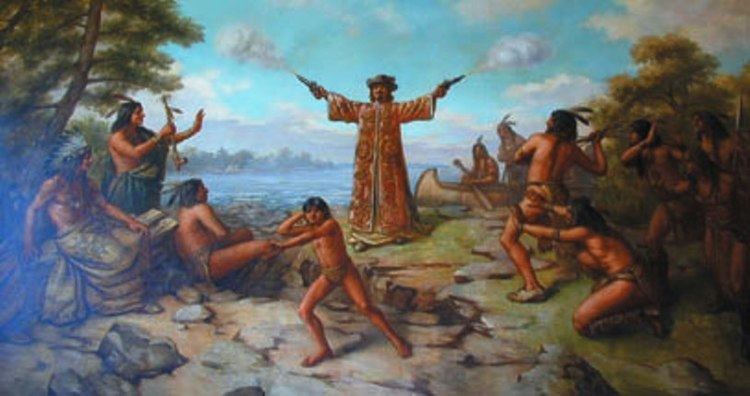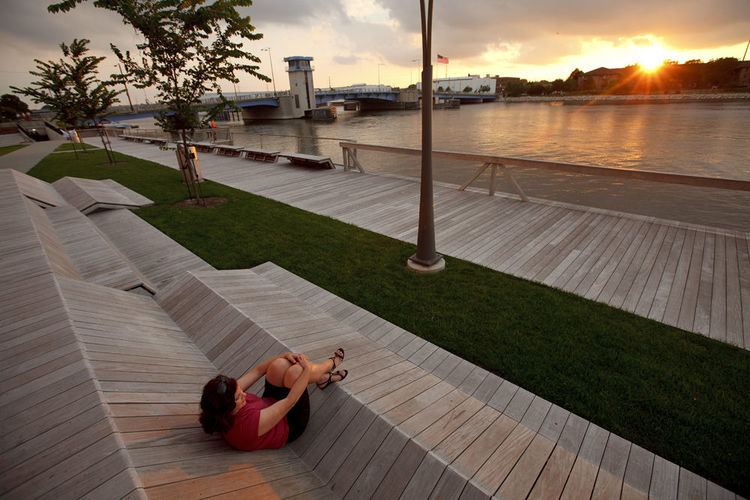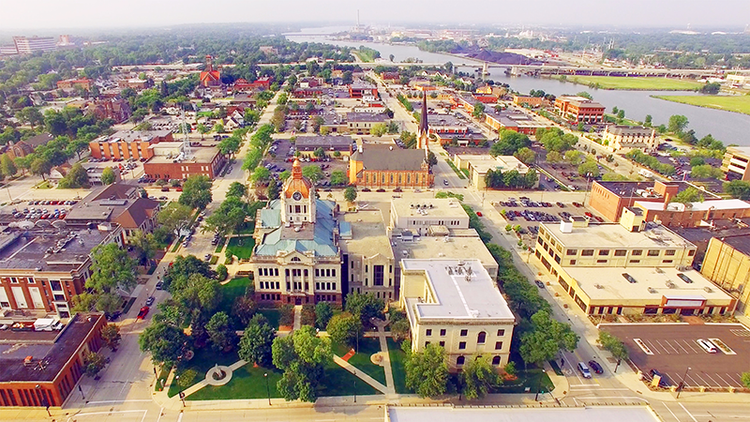Country United States State Wisconsin | Population 104,779 (2013) Area 55.96 sq mi Mayor Jim Schmitt | |
 | ||
Colleges and Universities University of Wisconsin–Green Bay, Globe University–Green Bay, Rasmussen College-Green Bay Points of interest Lambeau Field, Bay Beach Amusement Park, National Railroad Museum, Heritage Hill State Historical Park, Northeastern Wisconsin Zoo | ||
Unemployment rate 5.4% (Feb 2015) | ||
Map of Green Bay, Wisconsin
Green Bay is a city in and the county seat of Brown County in the U.S. state of Wisconsin, at the head of Green Bay, a sub-basin of Lake Michigan, at the mouth of the Fox River. It is 581 feet (177 m) above sea level and 112 miles (180 km) north of Milwaukee. The population was 104,057 at the 2010 census. Green Bay is the third-largest city in the state of Wisconsin, after Milwaukee and Madison, and the third-largest city on Lake Michigan's west shore, after Chicago and Milwaukee. Green Bay is home to the National Football League team Green Bay Packers.
Contents
- Map of Green Bay Wisconsin
- Cool places live in green bay wi 2006 the gogos best in live show audio
- Wpt in wisconsin history of the green bay packers
- History
- From the trading post La Baie des Puants to the town La Baie verte
- The British take over
- After Independence
- Geography
- Climate
- 2010 census
- 2000 census
- Government
- References

Green Bay is the principal city of the Green Bay Metropolitan Statistical Area, which covers Brown, Kewaunee, and Oconto counties; the MSA had a combined population of 306,241 at the 2010 census.

Green Bay is an industrial city with several meatpacking plants, paper mills, and a port on Green Bay, an arm of Lake Michigan known locally as "the Bay of Green Bay". Green Bay hosts the Neville Public Museum, with exhibitions of art, history, and science; the Children's Museum; and the University of Wisconsin–Green Bay.

Cool places live in green bay wi 2006 the gogos best in live show audio
Wpt in wisconsin history of the green bay packers
History
Samuel de Champlain, the founder of New France, commissioned Jean Nicolet to form a peaceful alliance with Native Americans in the western areas, whose unrest interfered with French fur trade, and to search for a shorter trade route to China through Canada. Nicolet and others had learned from other First Nations of the Ho-Chunk (Winnebago) people, who identified as "People of the Sea", and believed they must reside on or near the Pacific Ocean. Champlain had also heard about natural resources in the area, including fertile soil, forests, and animals. Nicolet began his journey for this new land shortly before winter in 1634. In what later became a French fur-trading route, he sailed up the Ottawa River, through Lake Nipissing and down the French River to Lake Huron, then through the straits of Michilimackinac into Lake Michigan. He is believed to have landed at Red Banks, near the site of the modern-day city of Green Bay, Wisconsin.
From the trading post La Baie des Puants to the town La Baie verte
Nicolet founded a small trading post here in 1634, originally named La Baye or La Baie des Puants (French for "the Bay of Stinking Waters"). Nicolet's settlement was one of the oldest European permanent settlements in America.
When Nicolet arrived in the Green Bay area, he encountered the Menominee, as this was their territory. He also met the Ho-Chunk, also known as the Winnebago, a people who spoke a Sioux language. The Winnebago hunted, fished, and cultivated corn, bean, squash, and tobacco. Wild rice, which they had incorporated as a dietary staple, grew in abundance along the riverbanks. They regularly harvested and cooked this, along with a wide variety of nuts, berries, and edible roots of the woods. The tribe had clearly distinguished gender roles. The men typically hunted and fished for food, and the women processed game and other foods in cooking. They prepared and made clothing from the furs as well as using other parts of animals for tools, cord, etc. Women also had a role in the political process, as no action could be taken without agreement of half of the women. Nicolet stayed with this tribe for about a year, becoming an ally. He helped open up opportunities for trade and commerce with them before returning to Quebec.
A few months after Nicolet returned to Quebec, Champlain died. His death halted other journeys to La Baie Verte (French for "The Green Bay"). Père Claude Allouez sent Nicolas Perrot to La Baie. After this, the French avoided the area for some decades, because of the intensity of First Nations and European conflicts in the east. In 1671, a Jesuit Mission was set up in the area. A fort was added in 1717 and gradually associated development took place. The town was incorporated in 1754. As Great Britain took control of French areas during the Seven Years' War, known as the French and Indian War in some areas of North America, this town came under British control in 1761. The French ceded their North American lands East of the Mississippi River to the British following defeat in 1763.
The first permanent French settlers were Charles de Langlade and his family from Canada, who moved to Green Bay in 1765, becoming the first European-American settlers in today's Wisconsin. Langlade, called the "Founder and Father of Wisconsin", was an Ottawa war chief with a French father. He is credited with planning the ambush of British General Braddock and George Washington in the French and Indian War. The Grignons, Porliers and Lawes, who followed, brought Canadian-French culture with them. Colorful "jack-knife Judge" Reaume dispensed British justice in the territory. These early French settlers set the tone for many who followed.
The British take-over
The British gradually took over Wisconsin during the French and Indian War, taking control of Green Bay in 1761 and gaining control of all of Wisconsin in 1763. Like the French, the British were interested in little but the fur trade. One notable event in the fur trading industry in Wisconsin occurred in 1791, when two free African Americans set up a fur trading post among the Menominee at present day Marinette. The first permanent settlers, mostly French Canadians, some Anglo-New Englanders and a few African American freedmen, arrived in Wisconsin while it was under British control. Charles Michel de Langlade is generally recognized as the first settler, establishing a trading post at Green Bay in 1745, and moving there permanently in 1764. Settlement began at Prairie du Chien around 1781. The French residents at the trading post in what is now Green Bay, referred to the town as "La Bey", however British fur traders referred to it as "Green Bay", because the water and the shore assumed green tints in early spring. The old French title was gradually dropped, and the British name of "Green Bay" stuck. The region coming under British rule had virtually no adverse effect on the French residents as the British needed the cooperation of the French fur traders and the French fur traders needed the goodwill of the British. During the French occupation of the region licenses for fur trading had been issued scarcely and only to select groups of traders, whereas the British, in an effort to make as much money as possible from the region, issued licenses for fur trading freely, both to British and French residents. The fur trade in what is now Wisconsin reached its height under British rule, and the first self-sustaining farms in the state were established as well. From 1763 to 1780, Green Bay was a prosperous community which produced its own foodstuff, built graceful cottages and held dances and festivities.
After Independence
The Green Bay area was still under British control until the 1783 treaty formally ended the American Revolutionary War. Following the War of 1812, which in part was over disputes related to the border with Canada, the United States built Fort Howard on the Fox River in 1816 to protect its northern border. Doty, Whitney, Arndt, Baird and Martin were among the many British-American settlers whose numbers pushed French culture into the background. As British settlers in the area came to outnumber the French, they referred to the town as "Green Bay" (from the French: Baie Verte).
The Erie Canal was completed in 1825, linking New England with the Great Lakes. This led to the advance of Green Bay as a trading center. The end of the Black Hawk War in 1832 also gave impetus to settlement of the region. Most of the settlers were farmers from New England who began using the Erie Canal to pour into Wisconsin. As more and more New England settlers arrived, Green Bay developed into a trading center for this population.
Wisconsin's first newspaper, The Green Bay Intelligencer, was started in 1833 by Albert Ellis and John V. Suydam. The borough of Green Bay, created in 1838, is the center of the present-day city. The borough combined the town of Astoria (a company town of the American Fur Company), with Navarino, platted by Daniel Whitney. Before Wisconsin became a state in 1848, its commerce was based on the fur trade, which became dominated by John Jacob Astor's American Fur Company. After statehood, there was a shift away from fur trading toward lumbering. "For a short time in 1860s and 1870s, iron smelting in charcoal kilns rivaled the timber industry while the port handled increasing amounts of fuel, feed, and lumber. Today's major local industry had its start in 1865 when the first paper mill was built."
By 1850 the town had a population of 1,923. The town was incorporated as the city of Green Bay in 1854. The Green Bay Area Public School District was founded in 1856. Throughout the 1850s, word spread of America's cheap land and good soil, bringing in an influx of Belgian people, German, Scandinavian, Irish and Dutch immigrants, each adding to the culture. The greatest concentration of newcomers came from Belgium. They cleared the land to farm and build their homes.
The railroad arrived in the 1860s. Chicago and Northwestern Railroad companies were formed, which allowed people and products to travel all over the state, increasing business and trade opportunities. The area was able to grow and enrich itself with the use of the river and the plentiful timber resources. This led to the paper industry becoming the major employer in Green Bay, and opened up the port for international trade.
In 1934, President Franklin D. Roosevelt came to Green Bay to honor its tercentenary. By 1950, the city had a population of 52,735. In 1964, the Town of Preble was consolidated with the city of Green Bay.
Geography
Green Bay is in the northeastern part of Wisconsin at the mouth of the Fox River. Today, Interstate 43 meets U.S. Route 41 in Green Bay, about 90 miles (140 km) north of Milwaukee.
According to the United States Census Bureau, the city has a total area of 55.96 square miles (144.94 km2), of which, 45.47 square miles (117.77 km2) is land and 10.49 square miles (27.17 km2) is water.
Climate
Green Bay has a humid continental climate (Köppen climate classification Dfb), with some moderation due to the city's proximity to Lake Michigan. Like other cities with this type of climate, there are four distinct seasons, often with severe or extreme variation between them in terms of temperature and precipitation. Green Bay experiences warm, humid, frequently hot summers and long, cold and snowy winters. The variance in temperature and precipitation between months is severe and often extreme. Tornadoes are rare in the Green Bay area, with the strongest being an F3 tornado that hit the community of Pittsfield on June 26, 1969.
Monthly mean temperatures range from 16.6 °F (−8.6 °C) in January to 69.1 °F (20.6 °C) in July. In July, the warmest month, the average high temperature is 81.2 °F (27.3 °C). There are 6.1 days of 90 °F (32 °C)+ highs, 68 days where the high remains at or below freezing, and 19 days with sub-0 °F (−18 °C) lows annually. From December to February, even during thaws, the temperature rarely reaches 50 °F (10 °C). Extremes have ranged from −36 °F (−38 °C) on January 21, 1888 to 104 °F (40 °C) on July 13, 1936.
The wettest month in Green Bay is August, when 3.77 inches (95.8 mm) of precipitation falls, mostly in the form of rainfall from thunderstorms. The driest month in Green Bay is February, when the majority of precipitation falls as low moisture-content snow due to cold, dry air. On average, 1.01 inches (25.7 mm) of precipitation falls in February.
2010 census
As of the census of 2010, there were 104,057 people, 42,244 households, and 24,699 families residing in the city. The population density was 2,288.5 inhabitants per square mile (883.6/km2). There were 45,241 housing units at an average density of 995.0 per square mile (384.2/km2). The racial makeup of the city was 77.9% White, 3.5% African American, 4.1% Native American, 4.0% Asian, 0.1% Pacific Islander, 7.2% from other races, and 3.1% from two or more races. Hispanic or Latino of any race were 13.4% of the population.
There were 42,244 households of which 31.4% had children under the age of 18 living with them, 40.4% were married couples living together, 12.5% had a female householder with no husband present, 5.6% had a male householder with no wife present, and 41.5% were non-families. 32.4% of all households were made up of individuals and 9.6% had someone living alone who was 65 years of age or older. The average household size was 2.39 and the average family size was 3.06.
The median age in the city was 33.7 years. 24.7% of residents were under the age of 18; 11.7% were between the ages of 18 and 24; 27.7% were from 25 to 44; 24.5% were from 45 to 64; and 11.3% were 65 years of age or older. The gender makeup of the city was 49.4% male and 50.6% female.
2000 census
As of the census of 2000, there were 102,313 people, 41,591 households, and 24,663 families residing in the city. The population density was 2,332.1 people per square mile (900.5/km2). There were 43,123 housing units at an average density of 982.9 per square mile (379.5/km2). The racial makeup of the city was 85.86% White, 1.38% African American, 3.28% Native American, 3.76% Asian, 0.04% Pacific Islander, 3.72% from other races, and 1.97% from two or more races. Hispanic or Latino of any race were 7.13% of the population.
There were 41,591 households of which 30.6% had children under the age of 18 living with them, 44.1% were married couples living together, 10.8% had a female householder with no husband present, and 40.7% were non-families. About 31.6% of all households were made up of individuals and 9.9% had someone living alone who was 65 years of age or older. The average household size was 2.40 and the average family size was 3.06.
In the city, the age distribution of the population shows 25.4% under the age of 18, 11.6% from 18 to 24, 31.7% from 25 to 44, 19.5% from 45 to 64, and 11.8% who were 65 years of age or older. The median age was 33 years. For every 100 females there were 97.2 males. For every 100 females age 18 and over, there were 94.8 males.
The median income for a household in the city was $38,820, and the median income for a family was $48,678. Males had a median income of $33,246 versus $23,825 for females. The per capita income for the city was $19,269. About 7.4% of families and 10.5% of the population were below the poverty line, including 12.7% of those under the age of 18 and 9.2% of those 65 and older.
Government
Green Bay is governed by a mayor and a city council. The mayor is elected in a citywide vote. The city council consists of 12 members each elected from districts.
